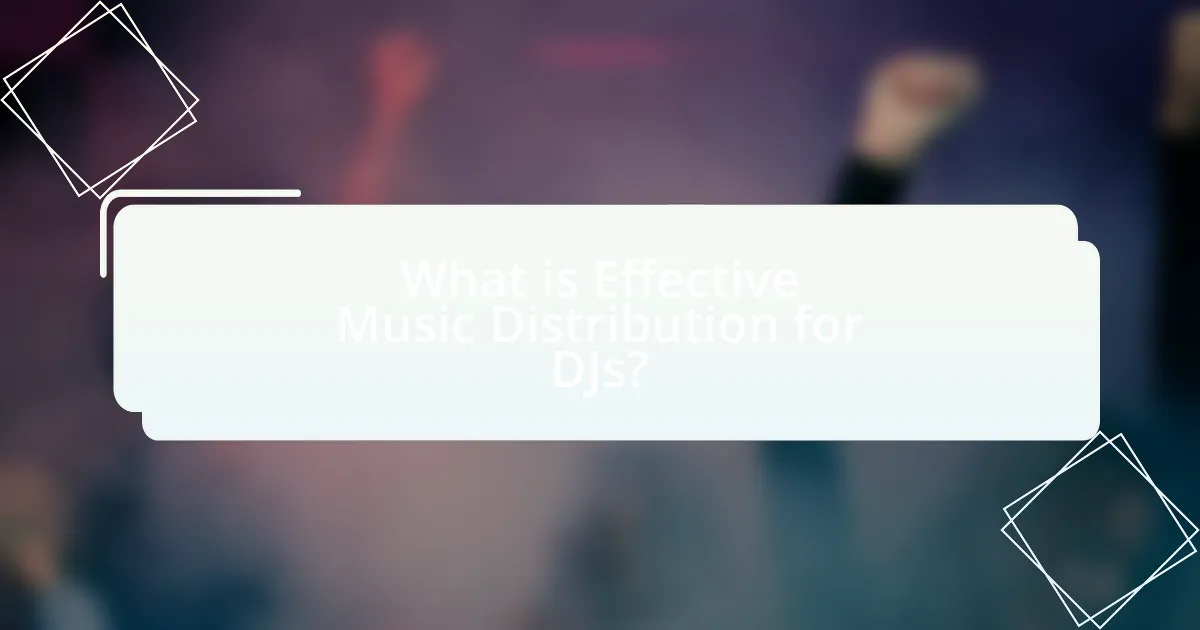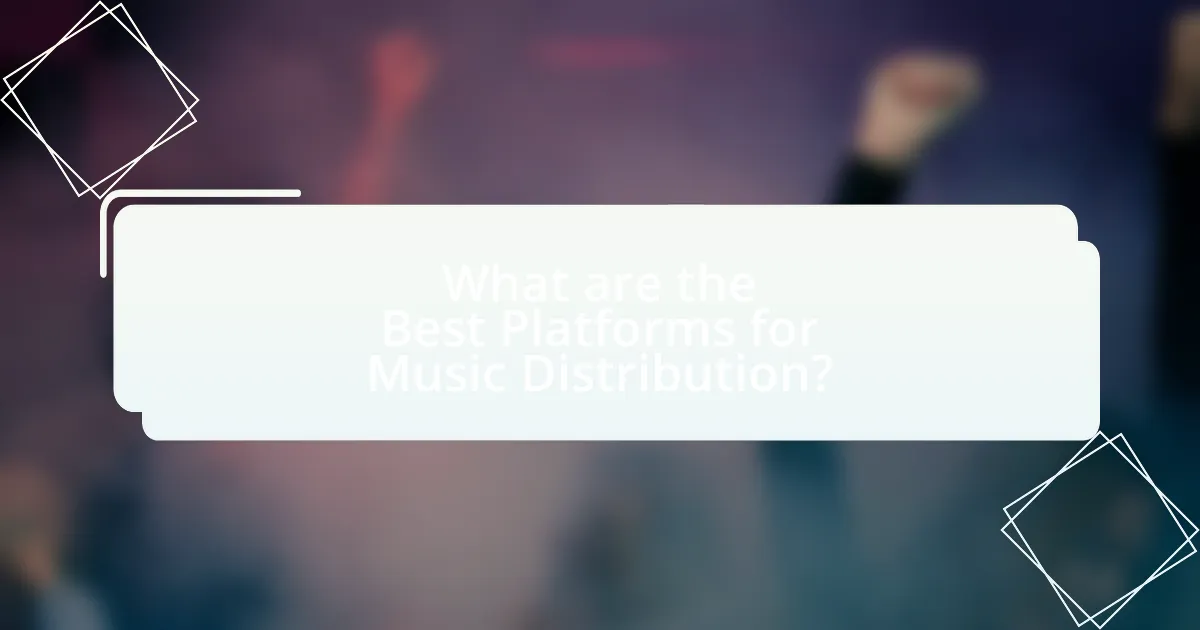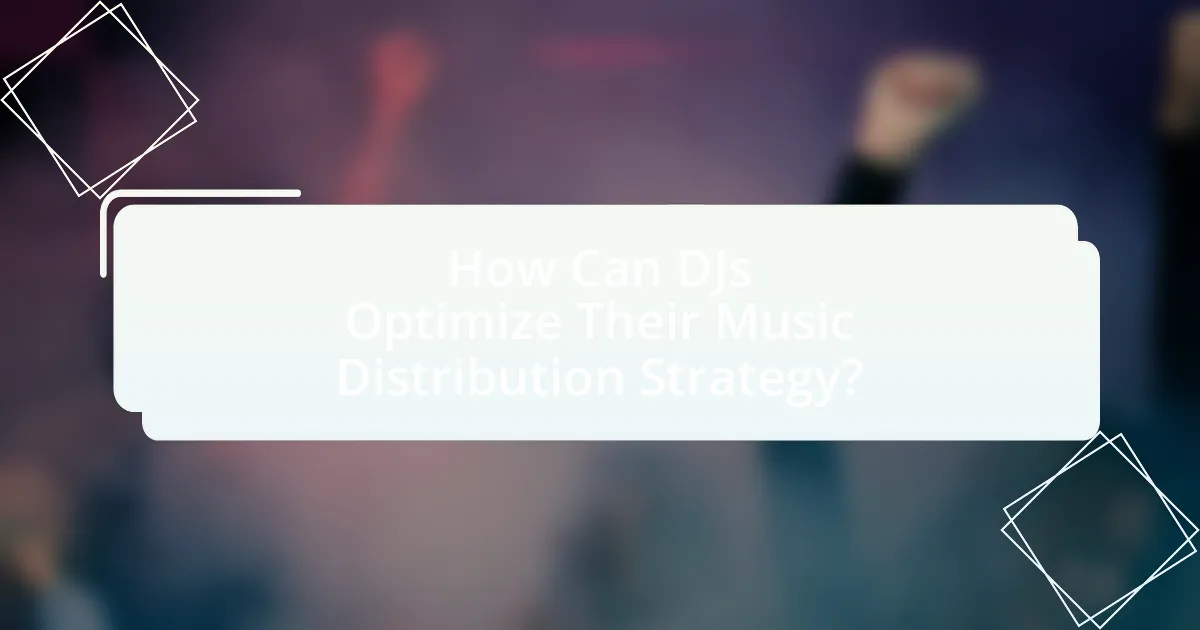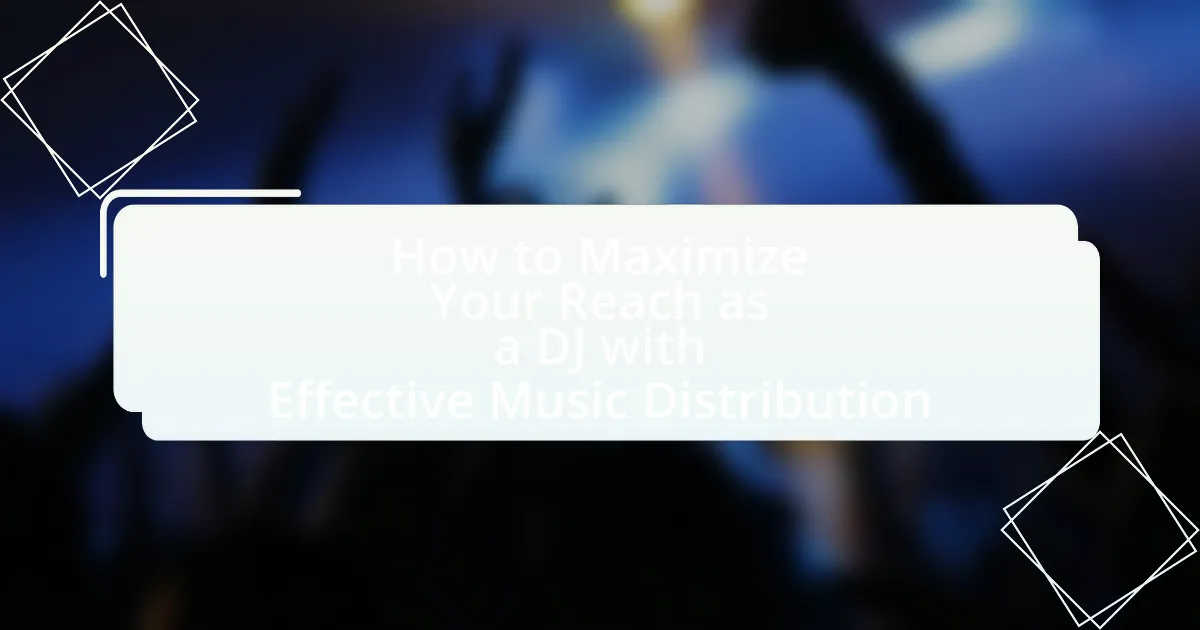Effective music distribution is essential for DJs aiming to maximize their reach and audience engagement. This article explores the significance of utilizing various digital distribution platforms, such as DistroKid and TuneCore, to ensure music is accessible on major streaming services like Spotify and Apple Music. Key components of music distribution, including marketing strategies and performance rights management, are discussed, along with the impact of different distribution methods on visibility and listener engagement. Additionally, the article outlines best practices for selecting distribution services, optimizing strategies, and maintaining audience engagement, providing DJs with actionable insights to enhance their presence in the competitive music industry.

What is Effective Music Distribution for DJs?
Effective music distribution for DJs involves strategically releasing music across various platforms to maximize audience reach and engagement. This includes utilizing digital distribution services like DistroKid or TuneCore, which ensure that tracks are available on major streaming platforms such as Spotify, Apple Music, and Beatport. Research indicates that DJs who leverage multiple distribution channels can increase their visibility and fan base significantly, as evidenced by a 2021 study from the International Journal of Music Business Research, which found that artists using comprehensive distribution strategies saw a 30% increase in listener engagement.
How does music distribution impact a DJ’s reach?
Music distribution significantly impacts a DJ’s reach by determining how widely their tracks are available to audiences across various platforms. Effective distribution channels, such as streaming services, digital downloads, and social media, enable DJs to connect with a global audience, increasing their visibility and potential fan base. For instance, according to a 2021 report by the International Federation of the Phonographic Industry, streaming accounted for 62% of the global recorded music market, highlighting the importance of being present on these platforms for maximizing reach. Additionally, utilizing platforms like Spotify and Apple Music allows DJs to gain insights into listener demographics and preferences, further enhancing their ability to target specific audiences and grow their following.
What are the key components of music distribution?
The key components of music distribution include digital distribution platforms, physical distribution channels, licensing agreements, marketing strategies, and performance rights management. Digital distribution platforms, such as Spotify and Apple Music, allow artists to upload and share their music globally, reaching a wide audience. Physical distribution channels involve the production and sale of physical formats like CDs and vinyl, which cater to specific markets. Licensing agreements ensure that artists receive royalties for the use of their music in various media, while marketing strategies help promote the music effectively to target audiences. Performance rights management organizations, like ASCAP and BMI, protect artists’ rights and ensure they are compensated for public performances of their work. These components collectively enhance an artist’s visibility and revenue potential in the music industry.
How do different distribution methods affect visibility?
Different distribution methods significantly impact visibility by determining how widely and quickly music reaches audiences. For instance, digital distribution platforms like Spotify and Apple Music enhance visibility through algorithm-driven playlists and recommendations, which can expose tracks to millions of listeners. In contrast, physical distribution methods, such as vinyl or CD sales, limit visibility to specific markets and demographics, often resulting in slower reach. Research indicates that digital platforms account for over 80% of music consumption, highlighting their crucial role in maximizing visibility for artists.
Why is music distribution crucial for DJs?
Music distribution is crucial for DJs because it enables them to reach a wider audience and monetize their work effectively. By distributing their tracks through various platforms, DJs can ensure their music is accessible to listeners globally, which is essential in a competitive industry where exposure directly impacts success. For instance, digital distribution services like Spotify and Apple Music allow DJs to tap into millions of potential fans, increasing their visibility and opportunities for bookings. Furthermore, effective distribution can lead to higher streaming revenues and the potential for chart placements, which further enhances a DJ’s reputation and marketability.
What advantages does effective distribution provide?
Effective distribution provides increased visibility and accessibility for a DJ’s music, allowing it to reach a broader audience. This expanded reach can lead to higher streaming numbers, increased sales, and greater opportunities for live performances. For instance, platforms like Spotify and Apple Music have millions of users, and effective distribution ensures that a DJ’s tracks are available on these platforms, maximizing potential listener engagement. Additionally, effective distribution can enhance brand recognition and credibility, as music is more likely to be discovered and shared when it is widely available across various channels.
How does distribution influence audience engagement?
Distribution significantly influences audience engagement by determining how and where content is made available to listeners. Effective distribution channels, such as streaming platforms and social media, enhance visibility and accessibility, leading to increased interaction and connection with the audience. For instance, a study by the International Federation of the Phonographic Industry (IFPI) found that 70% of music listeners discover new music through streaming services, highlighting the critical role of distribution in reaching potential fans. This accessibility fosters higher engagement rates, as audiences are more likely to interact with content that is readily available on their preferred platforms.

What are the Best Platforms for Music Distribution?
The best platforms for music distribution include DistroKid, TuneCore, and CD Baby. DistroKid allows artists to upload unlimited music for a yearly fee and distributes to over 150 platforms, including Spotify and Apple Music. TuneCore offers a pay-per-release model and provides detailed sales reports, making it suitable for artists who want control over their earnings. CD Baby is known for its one-time fee per release and offers additional services like physical distribution and sync licensing. These platforms are widely recognized in the industry for their reliability and extensive reach, enabling DJs to maximize their audience effectively.
How do various platforms differ in their offerings?
Various music distribution platforms differ in their offerings primarily in terms of pricing structures, distribution reach, and additional services. For instance, platforms like DistroKid offer unlimited distribution for a flat annual fee, while TuneCore charges per release, impacting cost-effectiveness for artists. Additionally, some platforms, such as CD Baby, provide physical distribution options alongside digital, which can enhance an artist’s market presence. Furthermore, services like Amuse focus on artist development and provide analytics tools, whereas others may not offer such features, affecting how artists can track their performance and engage with their audience. These differences highlight the importance of selecting a platform that aligns with an artist’s specific needs and goals in music distribution.
What are the top music distribution services available?
The top music distribution services available include DistroKid, TuneCore, CD Baby, and Amuse. DistroKid is known for its fast distribution and affordable pricing, allowing artists to keep 100% of their royalties. TuneCore offers extensive distribution options and detailed analytics, making it a popular choice for independent musicians. CD Baby provides a wide range of services, including physical distribution and sync licensing, catering to various artist needs. Amuse stands out with its free distribution model and artist-friendly approach, appealing to emerging musicians. These services are widely recognized in the industry for their reliability and effectiveness in helping artists reach a broader audience.
How do fees and royalties vary across platforms?
Fees and royalties vary significantly across music distribution platforms, impacting artists’ earnings. For instance, platforms like Spotify typically pay artists between $0.003 and $0.005 per stream, while Apple Music offers around $0.007 to $0.01 per stream. In contrast, Bandcamp allows artists to set their own prices and takes a 15% cut on digital sales, which can lead to higher earnings per sale compared to streaming services. Additionally, platforms like SoundCloud offer a monetization program that pays creators based on engagement metrics, which can further diversify income streams. These variations highlight the importance of choosing the right platform for maximizing revenue based on an artist’s distribution strategy.
What should DJs consider when choosing a distribution platform?
DJs should consider the platform’s reach, fees, and services when choosing a distribution platform. The reach of a distribution platform determines how many streaming services and stores will feature the DJ’s music, which is crucial for maximizing audience exposure. Fees can vary significantly; some platforms charge upfront costs, while others take a percentage of sales, impacting the DJ’s overall revenue. Additionally, services such as marketing support, analytics, and the ability to distribute to specific genres or regions can enhance a DJ’s promotional efforts and audience engagement. For instance, platforms like DistroKid and TuneCore are known for their extensive reach and user-friendly interfaces, making them popular choices among DJs.
How important is user interface and ease of use?
User interface and ease of use are critically important in maximizing reach as a DJ through effective music distribution. A well-designed user interface enhances user engagement, making it easier for DJs to navigate platforms, upload music, and manage their profiles. Research indicates that 88% of online consumers are less likely to return to a site after a bad experience, highlighting the necessity for intuitive design. Furthermore, platforms with user-friendly interfaces often see higher adoption rates, which can directly impact a DJ’s ability to distribute music effectively and reach a broader audience.
What role does customer support play in platform selection?
Customer support plays a critical role in platform selection by influencing user satisfaction and retention. A responsive and knowledgeable customer support team can address issues promptly, ensuring that DJs can focus on their music rather than technical difficulties. According to a study by HubSpot, 93% of customers are likely to make repeat purchases with companies that offer excellent customer service, highlighting the importance of support in maintaining a loyal user base. Therefore, when selecting a distribution platform, DJs should prioritize those with strong customer support to enhance their overall experience and maximize their reach.

How Can DJs Optimize Their Music Distribution Strategy?
DJs can optimize their music distribution strategy by utilizing multiple digital platforms to reach a broader audience. By distributing music through services like Spotify, Apple Music, and SoundCloud, DJs can tap into diverse listener bases and increase their visibility. Additionally, leveraging social media for promotion and engaging with fans directly can enhance their reach. According to a 2021 report by the International Federation of the Phonographic Industry, digital music revenues accounted for 62% of the global music market, highlighting the importance of effective online distribution.
What strategies can DJs implement for effective distribution?
DJs can implement several strategies for effective distribution, including leveraging digital platforms, utilizing social media marketing, and collaborating with music distributors. Digital platforms like Spotify and Apple Music allow DJs to reach a global audience, as these services have millions of active users. Social media marketing enables DJs to engage directly with fans, promoting new releases and upcoming events, which can increase visibility and drive traffic to their music. Collaborating with established music distributors can enhance reach, as these distributors often have established networks and promotional resources that can amplify a DJ’s presence in the music industry.
How can social media enhance music distribution efforts?
Social media enhances music distribution efforts by providing platforms for artists to directly engage with their audience, facilitating rapid sharing and promotion of music. For instance, platforms like Instagram and TikTok allow musicians to share snippets of their tracks, which can go viral and reach millions quickly, as evidenced by the fact that songs featured in TikTok trends often see significant increases in streaming numbers. Additionally, social media enables targeted advertising, allowing artists to reach specific demographics based on user data, which can lead to higher engagement and conversion rates. According to a 2021 report by the International Federation of the Phonographic Industry, 70% of music consumers discover new music through social media, highlighting its critical role in modern music distribution strategies.
What role does email marketing play in reaching audiences?
Email marketing plays a crucial role in reaching audiences by enabling direct communication with potential and existing fans. This method allows DJs to share updates, promote new releases, and engage with their audience on a personal level. According to a study by the Direct Marketing Association, email marketing has an average return on investment of $42 for every dollar spent, highlighting its effectiveness in reaching and converting audiences. Additionally, email campaigns can be tailored to specific segments of a DJ’s fanbase, ensuring that the content is relevant and engaging, which further enhances audience reach and retention.
How can DJs measure the success of their distribution efforts?
DJs can measure the success of their distribution efforts through metrics such as streaming numbers, download statistics, and audience engagement on social media platforms. By analyzing streaming data from platforms like Spotify and Apple Music, DJs can assess how many times their tracks are played, which indicates popularity and reach. Additionally, tracking downloads from digital stores provides insight into direct sales and consumer interest. Engagement metrics, such as likes, shares, and comments on social media posts related to their music, further reflect audience interaction and can indicate the effectiveness of promotional strategies. These metrics collectively offer a comprehensive view of a DJ’s distribution success, allowing for data-driven adjustments to future distribution strategies.
What metrics should DJs track to evaluate performance?
DJs should track metrics such as audience engagement, track play counts, social media interactions, and revenue generated from performances to evaluate performance. Audience engagement can be measured through the number of attendees at events and their interaction levels during performances. Track play counts provide insight into which songs resonate most with listeners, while social media interactions, including likes, shares, and comments, reflect the DJ’s online presence and fanbase growth. Revenue generated from performances indicates financial success and can be analyzed through ticket sales, merchandise, and streaming royalties. These metrics collectively offer a comprehensive view of a DJ’s performance and effectiveness in reaching their audience.
How can feedback from listeners inform distribution strategies?
Feedback from listeners can significantly inform distribution strategies by providing insights into audience preferences and engagement levels. Analyzing listener feedback, such as comments, ratings, and streaming data, allows DJs to identify which tracks resonate most with their audience. For instance, if a particular song receives high engagement on streaming platforms, DJs can prioritize its distribution across various channels to maximize reach. Additionally, feedback can reveal demographic trends, enabling targeted marketing efforts. According to a study by Nielsen Music, 70% of listeners are more likely to share music they feel a personal connection to, highlighting the importance of aligning distribution strategies with listener preferences to enhance visibility and audience growth.
What are the common pitfalls in music distribution for DJs?
Common pitfalls in music distribution for DJs include inadequate understanding of distribution platforms, failure to optimize metadata, and neglecting promotional strategies. DJs often choose platforms without researching their audience reach or terms, which can limit exposure. Additionally, poor metadata, such as missing genre tags or incorrect track information, can hinder discoverability on streaming services. Lastly, many DJs overlook the importance of marketing their releases, resulting in minimal engagement and reduced sales. These factors collectively impede a DJ’s ability to maximize their reach and impact in the music industry.
How can DJs avoid oversaturation in the market?
DJs can avoid oversaturation in the market by focusing on niche genres and developing a unique brand identity. By specializing in a specific style of music, DJs can differentiate themselves from the competition, attracting a dedicated audience. For instance, according to a study by the International Music Summit, niche genres often have less competition, allowing artists to build a loyal fan base more effectively. Additionally, engaging with fans through social media and live performances can enhance their visibility and strengthen their brand, further reducing the risk of oversaturation.
What mistakes should DJs avoid when selecting a distribution service?
DJs should avoid selecting a distribution service that lacks transparency regarding fees and royalties. Many distribution services have hidden costs that can significantly reduce a DJ’s earnings, making it crucial for DJs to thoroughly review the fee structure before committing. Additionally, DJs should be wary of services that do not provide clear information about the platforms where their music will be distributed, as limited reach can hinder their ability to maximize exposure. Furthermore, DJs must avoid services with poor customer support, as timely assistance is essential for resolving issues that may arise during the distribution process. Lastly, DJs should not overlook the importance of reading reviews and testimonials from other artists, as this feedback can provide insight into the reliability and effectiveness of the distribution service.
What are the best practices for maximizing reach as a DJ?
To maximize reach as a DJ, focus on building a strong online presence through social media, streaming platforms, and engaging with your audience. Establishing profiles on platforms like Instagram, Facebook, and TikTok allows DJs to share mixes, promote events, and connect with fans. Utilizing streaming services such as Spotify and SoundCloud for music distribution increases visibility, as these platforms have millions of users actively seeking new music. Engaging with followers through regular updates, live streams, and interactive content fosters a loyal community, which can lead to increased word-of-mouth promotion. Collaborating with other artists and participating in events or festivals can also expand your audience base, as it exposes your work to new listeners. According to a study by the International Music Summit, 70% of DJs reported that social media significantly contributed to their career growth, highlighting the importance of these practices in maximizing reach.
How can collaboration with other artists enhance distribution?
Collaboration with other artists enhances distribution by leveraging each artist’s audience and networks, thereby increasing exposure. When artists work together, they can cross-promote their music to each other’s fan bases, which can lead to a broader reach. For instance, a study by Nielsen Music found that collaborations often result in higher streaming numbers, as fans of both artists are likely to engage with the new release. Additionally, platforms like Spotify and Apple Music often feature collaborative tracks prominently, further amplifying visibility. This strategic partnership not only diversifies the listener demographic but also creates opportunities for shared marketing efforts, ultimately maximizing distribution effectiveness.
What tips can DJs follow to maintain consistent engagement with their audience?
DJs can maintain consistent engagement with their audience by regularly interacting through social media, live streaming, and personalized playlists. Engaging on social media platforms allows DJs to share updates, respond to fan comments, and create a sense of community, which is crucial for audience retention. Live streaming performances can enhance real-time interaction, enabling DJs to connect with fans directly and receive immediate feedback. Additionally, curating personalized playlists based on audience preferences can foster a deeper connection, as it shows attentiveness to listeners’ tastes. Research indicates that active social media engagement can increase audience loyalty by up to 30%, highlighting the effectiveness of these strategies.

Leave a Reply